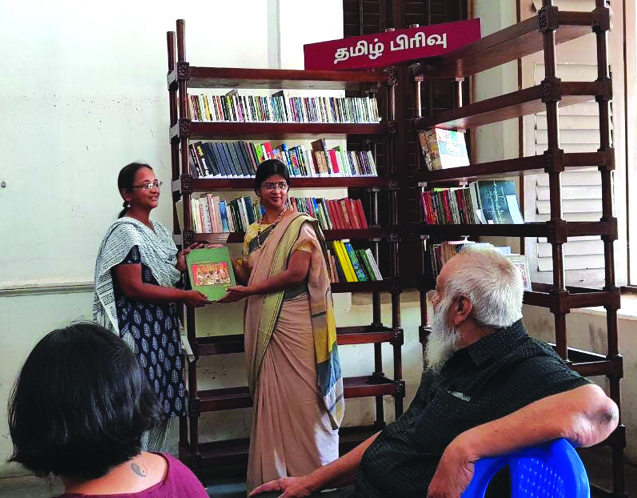Registered with the Registrar of Newspapers for India under R.N.I 53640/91
Vol. XXVIII No. 2, May 1-15, 2018
Now, a Tamil Section at the MLS
by A Staff Reporter with inputs from Nivedita Louis

At the opening of the MLS Tamil section.
The Madras Literary Society re-launched recently its Tamil Section. The long overdue initiative was a dream of MLS’s former Secretary Rear Admiral Mohan Raman. The dream took shape last year when heritage enthusiast and author of Holy Gods of Cooum, Padmapriya Baskaran, donated Rs.25,000 at the release of her book at the MLS. The donation was specifically for a separate Tamil section.
MLS has a large collection of Tamil books, the oldest one being a hand-written Ramayana dating to the 18th Century. However, over the course of time, only English books were lent. Continuous donations from people however kept the dream of a Tamil section alive and, finally, with about 400 books, the new Tamil Section has been started.
After the inaugural function, a passage from Chozhar Kaalathu Rani by J. Rajagopal, and a Tamil translation of a bit from S. Muthiah’s book Madras Rediscovered were read, and then two books were handed over by Padmapriya Baskaran to two senior members of MLS. This, was followed by a talk by historian and author Theodore Baskaran titled From Print to Screen. He spoke at length about how literature evolved into cinema and the interaction between them, though mutual, was not continuous.
He began with a brief of how cinema as a medium evolved from drama, from Pratapa Mudaliyar Charithiram the first Tamil novel, and how literature played a part in movies. He mentioned Ponmudi, the movie written by Barathidasan that kick-started the Dravidian movement in 1950. Parasakthi by Kalaignar in 1952 and Velaikkari by Anna in 1954 carried on the torch. Then came Anna’s Rangoon Radha in 1956 which when made into a movie diluted the radicalism of the novel.
Two films by Jeyakanthan, Unnai pol oruvan in 1965, and Yarukaga azhuthan in 1965, both very realistic natural cinema, were written and directed by him. Nimai Ghosh shot the movie Yarukaga azhuthan. He was a contemporary of Satyajit Ray, and stayed in Madras to shoot the film. KiRa’s Kidai, the poignant novel set in 1930s, was made as Oruthi in 2003, directed by Amshan Kumar.
Rajaji wrote the novel Thikkatra Parvathi, filmed in 1974, which was about a drunkard. The film bombed, probably because it showed the hero addicted to toddy! Rajaji being a teetotaller had no idea about toddy and other liquor, Theodore mused. Anuradha Ramanan’s Sirai was filmed in 1984. But, a great work of literature need not make a great film, felt Baskaran.
When he explained Thillana Mohanambal by Kothamangalam Subbu was a movie so badly made, in a very primitive ‘drama’ style, the audience was shocked! Was it not a big block-buster of those days?
He also mentioned that short stories could be made as great films. He cited Baskar Sakthi’s 2011 story Azhagar samiyin Kuthirai, which had brilliant surrealistic scenes that speak very subtly against superstition. Another short film, Thakkaiyin meedhu nangu kangal filmed in 2005 was also a great adaptation of a short story. Sadly, he felt, except for Jeyakanthan and ThiJa, most writers, including Asokamitran, Imaiyam, JeMo, Perumal Murugan, Rajam Krishnan, were ignored.

